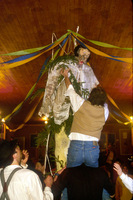 | Back to e-WV
| Back to e-WV
 The West Virginia Encyclopedia
The West Virginia Encyclopedia
 | Back to e-WV
| Back to e-WV
 The West Virginia Encyclopedia
The West Virginia Encyclopedia

Fasnacht is the last wild splurge before Lent, the ancient Christian period of fasting, self reflection, penance, and abstinence from meat beginning on Ash Wednesday and lasting 40 days until Easter. Corresponding to Mardi Gras, Carnival, and similar celebrations, the Fasnacht was brought to Randolph County from Switzerland by the settlers of Helvetia. They combined this traditionally Catholic celebration with the Protestant Winterfest of Zurich, wherein Old Man Winter is burned in effigy to hasten the advent of spring.
Helvetians prepare for Fasnacht by deep-frying donuts, rosettes, and hosenblatt pastries in lard, a meat by-product foregone during Lent. They decorate the community hall in colorful Swiss lampions (paper lanterns with candles), ribbons, and a gruesome Old Man Winter hanging by the neck in the middle of the dance floor. And they create elaborate masks.
At dark on the Saturday night before Ash Wednesday, the villagers and guests don their masks, congregate at the local restaurant, light lampions, then proceed up the road to the community hall where they parade around the dance floor as their masks are judged. They dance schotisches, waltzes, polkas, and squares until midnight, when the fiddler announces the hour to burn Old Man Winter. The prettiest maiden then mounts the shoulders of the tallest man and cuts down the ghoul. He is dragged out into the snow, roughed up and cursed, then thrown onto the bonfire amid applause.
Written by Bruce Betler
Sutton, David H. One's Own Hearth Is Like Gold: A History of Helvetia. New York: Peter Lang, 1990.
Mailloux, Eleanor Fahrner. Oppis guet's vo Helvetia. Helvetia: Alpen Rose Garden Club, 1969.
Milnes, Gerald. Helvetia: The Swiss of West Virginia. Video. : 1993.